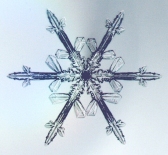 |
Of
Snowflakes, |
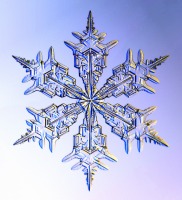 |
|
February 12, 2006 was the biggest snowfall in New York’s history: about 26.9 inches fell in the New York City area. While most of us either cursed the snow and got out our shovels, or excitedly made forts and threw snowballs, my attention was taken not by snow en masse but snow in its most basic component, the snowflake. Just watching out the window, I could tell that these snowflakes were going to be spectacular. I grabbed a square of black velvet from a jewelry box and headed out, where I investigated the snowflakes that landed on my square. This was a veritable bonanza—in addition to the usual stellar dendrites, I found radiating stellar dendrites, fernlike stellar dendrites, and hexagonal crystals. |
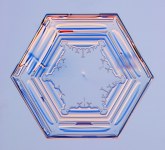 Simple prism
|
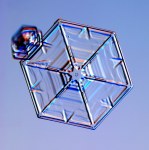 Hexagonal crystal
|
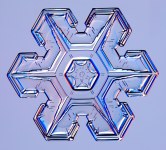 Stellar plate
|
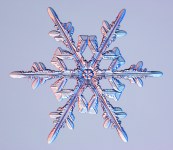 Stellar dendrite |
| Anyone who wants to know more about snowflakes should pick up a copy of Kenneth G. Libbrecht’s beautiful and informative book, The Snowflake: Winter's Secret Beauty and go to his site, snowcrystals.com. Libbrecht, professor of physics and chairman of the physics department at the California Institute of Technology covers the physics of snow, the different types of snowflakes, the joys of snowflake watching and how to photograph snow crystals. He also kindly gave permission to use these amazing photos of snowflakes from his site, much appreciated since my own attempts to photograph snowflakes came to naught. |
|
As you notice, many snowflakes are six-pointed. That’s because H2O molecules line up in a hexagonal pattern. According to Libbrecht, “Each red ball represents an oxygen atom, and the grey sticks represent hydrogen atoms. There are two hydrogens for each oxygen, making the usual H2O.” This, dare I say, makes snowflakes similar to hexaflexagons; indeed, if you are at a loss for a design for a hexaflexagon side, a snowflake always works beautifully. |
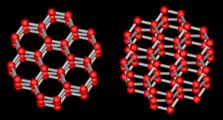 |
| The snow crystals grow by faceting and branching, processes that depend on temperature and humidity. Two common forms of the snow crystal are the hexagonal prism, in which certain surfaces of the crystal grow more slowly, and the stellar dendrite, the all-too-familiar branching structure that is the epitome of what most of us consider snowflake design. Stellar dendrites are found under higher humidity. When a bump forms on the surface, water molecules reach the bump before the rest of the crystal, meaning the bump grows faster. This instability causes the snow crystals to take on this beautiful form. | 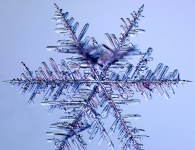 Radiating stellar dendrite |
 Fernlike stellar dendrite |
| Not all forms of ice have a hexagonal structure. In addition to ice as we know it, which scientists call Ice Ih, there’s Ice Ic, which are ice crystals high up in the atmosphere that form cubic crystals. At even higher pressures, the structure is more compact and dense and no longer hexagonal. Scientists have created Ice II through XI in the laboratory, including Ice IX, which forms a tetragonal crystal lattice and is not to be confused with Ice-9, the doomsday device devised by Kurt Vonnegut in Cat’s Cradle. Scientists think that some of these icy variations could exist in the outer reaches of the solar system. |
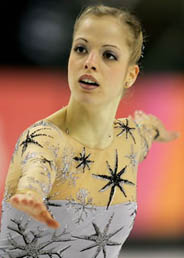 |
While on the subject of ice, I must detour to figure skaters at the Winter Olympics. With the fairer but duller scoring system in place, the skaters seemed to be competing mostly for the honor of who had the most hideous costume. In my opinion, the gold medal was won by the men’s silver medalist, who skated to Vivaldi’s Four Seasons in what looked like different colored zebra stripes on front and back and long blue sleeves. What on earth was he thinking? Best costume and interpretation had to go to Italian Carolina Kostner who skated, coincidentally, to Vivaldi and represented—a snowflake! |
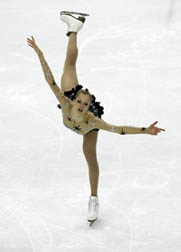 |
|
Anyway, let’s leave the cold depths of outer space and Torino’s ice rinks and backtrack back to my snowflake gazing in my own backyard. I could have stood for hours staring at these tiny treasures, each so ephemeral. Staring at snowflakes started to take over my mind—it was as if I could no longer see snow as a huge entity, something for snowplows to scoop away like so much detritus. We’ve certainly heard the analogy of snowflakes being compared to people. Like us, snowflakes vary, each is worthy of inspection and appreciation. Gathered in large groups (crowds, countries, PTAs, snowforts, avalanches) we both become something greater and simultaneously lesser. |
Copyright©EighthSquare.com P.O. Box 580 New York, NY 10113
